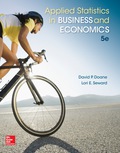
Concept explainers
Find the margin of error for a poll, assuming that π = .50.
- a. n = 50
- b. n = 200
- c. n = 500
- d. n = 2,000
a.
Find the margin of error for a poll assuming
Answer to Problem 32SE
The margin of error for a poll assuming
Explanation of Solution
Calculation:
The given information is that
Margin of error for a poll:
The formula for the Margin of error for a poll typically based on a 95% confidence level is,
From TABLE 8.9: Common Confidence Levels and z-Values, the z-value at 95% confidence level is 1.96.
Substitute
Thus, the margin of error for a poll assuming
b.
Find the margin of error for a poll assuming
Answer to Problem 32SE
The margin of error for a poll assuming
Explanation of Solution
Calculation:
The given information is that
Substitute
Thus, the margin of error for a poll assuming
c.
Find the margin of error for a poll assuming
Answer to Problem 32SE
The margin of error for a poll assuming
Explanation of Solution
Calculation:
The given information is that
Substitute
Thus, the margin of error for a poll assuming
d.
Find the margin of error for a poll assuming
Answer to Problem 32SE
The margin of error for a poll assuming
Explanation of Solution
Calculation:
The given information is that
Substitute
Thus, the margin of error for a poll assuming
Want to see more full solutions like this?
Chapter 8 Solutions
Applied Statistics in Business and Economics
- A company found that the daily sales revenue of its flagship product follows a normal distribution with a mean of $4500 and a standard deviation of $450. The company defines a "high-sales day" that is, any day with sales exceeding $4800. please provide a step by step on how to get the answers in excel Q: What percentage of days can the company expect to have "high-sales days" or sales greater than $4800? Q: What is the sales revenue threshold for the bottom 10% of days? (please note that 10% refers to the probability/area under bell curve towards the lower tail of bell curve) Provide answers in the yellow cellsarrow_forwardFind the critical value for a left-tailed test using the F distribution with a 0.025, degrees of freedom in the numerator=12, and degrees of freedom in the denominator = 50. A portion of the table of critical values of the F-distribution is provided. Click the icon to view the partial table of critical values of the F-distribution. What is the critical value? (Round to two decimal places as needed.)arrow_forwardA retail store manager claims that the average daily sales of the store are $1,500. You aim to test whether the actual average daily sales differ significantly from this claimed value. You can provide your answer by inserting a text box and the answer must include: Null hypothesis, Alternative hypothesis, Show answer (output table/summary table), and Conclusion based on the P value. Showing the calculation is a must. If calculation is missing,so please provide a step by step on the answers Numerical answers in the yellow cellsarrow_forward
 Holt Mcdougal Larson Pre-algebra: Student Edition...AlgebraISBN:9780547587776Author:HOLT MCDOUGALPublisher:HOLT MCDOUGAL
Holt Mcdougal Larson Pre-algebra: Student Edition...AlgebraISBN:9780547587776Author:HOLT MCDOUGALPublisher:HOLT MCDOUGAL Algebra: Structure And Method, Book 1AlgebraISBN:9780395977224Author:Richard G. Brown, Mary P. Dolciani, Robert H. Sorgenfrey, William L. ColePublisher:McDougal Littell
Algebra: Structure And Method, Book 1AlgebraISBN:9780395977224Author:Richard G. Brown, Mary P. Dolciani, Robert H. Sorgenfrey, William L. ColePublisher:McDougal Littell Glencoe Algebra 1, Student Edition, 9780079039897...AlgebraISBN:9780079039897Author:CarterPublisher:McGraw Hill
Glencoe Algebra 1, Student Edition, 9780079039897...AlgebraISBN:9780079039897Author:CarterPublisher:McGraw Hill Mathematics For Machine TechnologyAdvanced MathISBN:9781337798310Author:Peterson, John.Publisher:Cengage Learning,
Mathematics For Machine TechnologyAdvanced MathISBN:9781337798310Author:Peterson, John.Publisher:Cengage Learning,




